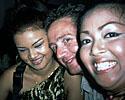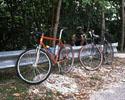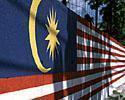
| LTdL Home |
| Trent Wilson diary |
| 2002 LTdL |
| Official Site |
Recently on Cyclingnews.com |
Steve Thomas' own Tour de Langkawi, part I
By Steve Thomas
Escaping the perils of a British winter, Steve Thomas saddles up and hits the road in Malaysia to check out some of the route (and much more) for the impending Tour de Langkawi. Over the next week he'll be reporting on his rides, giving an insight into cycling in the country. He will also be gazing into his crystal ball to predict what will be happening as the race travels the same roads.
Kicking off in style he heads for the holiday paradise island of Langkawi, and then rides south…
Oh island in the sun
|
Mystic Steve's race predictions The prologue is short and fast. Last year Robbie Hunter turned up trumps on this stage, but he's not here this year. It'll be fairly open, but I'd have an each way bet on Nathan O'Neill, Stuey O'Grady and maybe even Roland Green. Back on the road, it's going to be super fast, and with a number of finishing circuits around Butterworth it really should come down to a bunch sprint, Unless there's a split in the bunch I figure you'll see Gordon Fraser, O'Grady and the other sprinters at the head of the charge. |
Okay, so the three inch square map of the island featured in the guidebook must be wrong, or at the very least not quite right. I was absolutely nowhere near where I figured I was, and disaster was about to strike; the plan was a gentle meander through the lanes, then a ride up Gunang Raya, the high spot of the island. I could see the damn mountain, even if I was lost.
Then I pulled off my sunglasses, poked myself in the eye and popped my contact lens out. I was effectively now half-lost and half-blind, I had taken so many kampung back roads to get here, and could now not remember the route back to the hotel or even read the road signs. There was trouble in paradise. Thankfully the island isn't all that big, so I surmised that as long as I followed my nose in vaguely the right direction I'd get there in the end, and needless to say I did.
By day two, I'd seconded a larger scale map and hit the road once more in the hunt for Raya. The great thing about cycling in Langkawi is that there are hundreds of back roads, very few cars, and the terrain is incredibly varied - perhaps the best cycling territory in the whole country. Taking full advantage of the narrow kampung roads I eventually plotted my way to the foot of the mighty Raya. I know the race is only here for the prologue this time around, but there was no way I was travelling all this way to ride just 9 kilometres, and a long weekend seemed just the ticket.
I'd read race reports from the Eagle Tour of Malaysia, which is how I knew of Raya. But I had figured it would be just a 5 or 6 km pootle, so you can imagine my horror when I hit the 13 km to go sign and the road jacked up violently into the jungle clad hillside. It was hot, sweaty and gruelling, but is a must do for any cyclist heading to the island!
With Raya slain, my weekend was rounded off nicely with a rolling coastal ride around the north shore of the island, a great way to say goodbye to this island heaven before winding my way south through the limestone hills of the mainland en route to Penang, Malaysia's other major island holiday spot.
The race rolls along this stretch with ease to a stage finish in Butterworth, which is the town on mainland side of the impressive Penang Bridge. It has visited the island in the past, but has no time to stop over this year - unlike myself.
I managed to squeeze in a circular island tour and a few beers before a bizarre late night trishaw ride around Georgetown, the island's old colonial capital. It has a very Chinese feel to it, and seeing as the race arrives here at Chinese New Year I'm sure the riders and fans will be treated to something special.
This eastern side of the island is very busy, but as soon as you get out of town, things quieten down some. The road weaves around the northern coastline before taking in a long climb to the other side of Penang, a fascinating place. It is a complete contrast to the east side; here it's stilt housed kampungs and peaceful palm lined roads and one long climb back over the hills to town. For me it's time for a few more late night beers and another trishaw ride before heading east, to sample the reputed delights of the east coast…
Langkawi & Penang must do's
- Ride up Gunang Raya.
- Take advantage of Langkawi island's duty free status.
- Stay at the Langkawi Sheraton Beach Resort
- Spend an evening eating and drinking at one of Pantai Chenang's superb restaurants.
- Take a ride in the newly constructed Langkawi cable car.
- Take a night-time trishaw ride around Georgetown.
- Ride the funicular railway up Penang Hill.
- Check out west Penang's beach kampungs.
A guide to Langkawi
Climate
The climate in Malaysia is typically tropical, which means it is hot and humid all year round. During the western winter months, it also rains most days, though often heavy it is not usually for too long. In the hill country, temperatures are considerably cooler, though still comparatively warm they do make for a pleasant escape from the intense humidity of the flat lands. The west coast tends to get a more concentrated monsoon season during the period from October through till March, making this not the best time for cycling the classic east coast route.
Health
Malaysia is perhaps the cleanest and healthiest of South East Asian countries. Hygiene and medical standards are quite high. Even so, you do need to be careful with your eating and drinking; avoid non-bottled water and drinks containing ice, try to stick to cooked foods, unless you know they come from a clean kitchen, and avoid obviously re-heated street food.
Insect bites can be a real problem in jungle areas, so make sure you are always well coated with insect repellent. Leeches are only really a problem when you get off the beaten track in to humid or wet jungle areas. Leeches themselves are not harmful, a side flick or a match burn will release then - do not try pulling them off, as they will just bite deeper. The danger comes from the open wound they leave behind - so be sure to clean any wounds and dress with iodine. On the peninsula, malaria is not generally a problem, but check this well beforehand with your GP. Also check out latest recommendations for jabs.
Dehydration can be a serious problem here, so be sure to drink loads of water. After a couple of sweaty hours in humid conditions, you will really notice its effects. Be sure to use plenty of sun block too. For travelling in this region your medical kit should contain painkillers, bandages, plasters, iodine, antiseptic cream, and re-hydration fluids, antibiotics and Imodium tablets for emergencies.
Cultural
Malaysia is a Muslim country, and although not so extreme in its manifestation as many countries, it is still very apparent, and should be noted. The population is made up of a mixture of original Malays, with Chinese and Southern Indians making up the majority of the other inhabitants, creating a real melange of races and cultures, which generally works well together. There are no real political problems or dangers in Malaysia.
Accommodation
Accommodation is quite inexpensive and abundantly available all over peninsular Malaysia. You can pay as little as US$4, or as much as US$100 per night, depending on taste and budget. Standards vary, but on the whole rooms are clean and most have roof fans - air conditioning usually costs extra. Popular backpacking destinations such as Cameron Highlands and Penang are particularly well served with budget lodging options. During Chinese New Year, KL and other popular holiday destinations can often get fully booked out. Camping is not so popular in Malaysia, and with the number of budget options, there is no real need to cart around pannier loads of gear.
Eating and drinking
Without a doubt, Malaysia has to be South East Asia's finest culinary gem. The multi racial society is reflected in the amazing variety of cuisine available. Typical Malay cuisine is perhaps the least common of every day food in the country. It is generally quite spicy, and often contains fish and chill and is served with rice, traditionally on banana leaves and eaten by hand. Fried bananas are another delicacy, usually sold by roadside street vendors.
A typical Malay breakfast is either nasi lemak, which is coconut milk rice topped with chilli and anchovies, or roti cannai, a simple fried roti bread and a light vegetable curry. The most popular of Malaysian dishes is of course satay, which is available almost everywhere. The town of Kajang, south of KL, is known as the world's satay capital. More popular everyday foods are Chinese and Indian, which are available everywhere, and are some of the finest that you'll find anywhere in the world.
The predominant Chinese styles in Malaysia are Cantonese and Hokkien, though just about everything is available. If you get chance then you should try Steamboat; this is more or less a Chinese style fondue, where you boil skewered meats and vegetables in hot water at your table, then pay for the number of skewers you eat.
The Indian cuisine is largely from the South, meaning that it's hot and predominantly vegetarian. Tandoori is also quite common, as well as the less spicy and meat heavy Muslim Indian food.
Malaysia is a Muslim country, so alcohol is not always available. Most Chinese restaurants serve beer, and sometimes even wine or spirits - but it's not cheap. Indian and Muslim restaurants generally do not serve alcohol. On the east coast, where the Muslim religion is particularly strong it's almost impossible to buy alcohol. Most dining in Malaysia will either take place in a coffee shop, or at street cafes. At street cafes, you can often select particular dishes from a number of specialist stalls, which is a great and authentic way to eat.
Generally, food sold by street vendors is safe, and tasty. Fresh fruit juice is a popular tipple, as are tea and coffee - though it tends to be extremely creamy and sweet. Ice lemon tea, usually served in a plastic bag with a straw is a great refresher on a hot day. Most cities also have the obligatory Starbucks and Macdonald's, unfortunately.
For more detailed info check out the Lonely Planet guide to Malaysia.
Steve Thomas' own Tour de Langkawi
Part I - Oh island
in the sun
Part II - On
tour in Malaysia, the eastern delights
Part III - Mr
T meets 'The Beast of the East'




